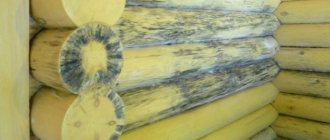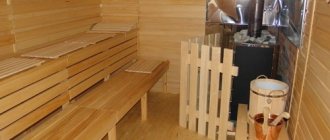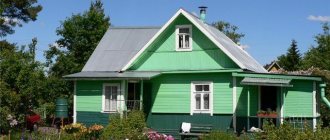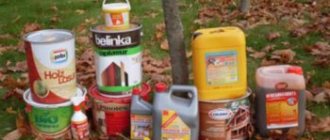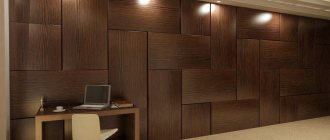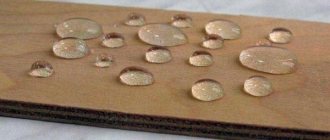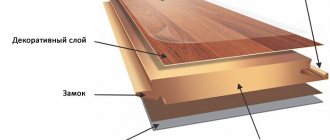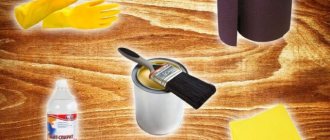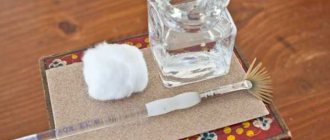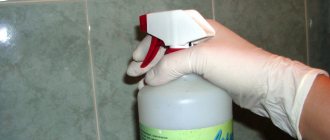Protective compounds and their properties
For the sake of order, it is necessary to mention such a remedy as drying oil, which used to cover all the insides in the bathhouse. It is still used today, but it should not be used in a steam room. It will be cheap, but cheerful. In terms of protective properties, this is yesterday, and the smell from it when heated well is not pleasant.
Water-dispersed impregnations
They are made on a water basis, so they penetrate deeply into the wood structure. They are resistant to high temperatures, do not contain active chemical components and do not emit any harmful compounds when heated. Modern water impregnations contain antibacterial components. Available both colorless and with added dyes.
The disadvantage is their fragility. Over time, under the influence of water, they are washed out of the wood, so the impregnation must be renewed every two years.
Oil impregnations and varnishes
They impregnate and protect wood well from moisture, forming a film. But their inherent smell is a significant drawback.
Therefore, they must be used with caution in the steam room. They are quite suitable for external impregnation and for protecting wood in the dressing room.
The varnish preserves the appearance of the wood, giving it a mysterious shineSource freepatriot.club
Acrylic based varnishes
Acrylic varnish for baths inside is considered safe. A modern product made from polyacrylates and organic solvents. Environmentally friendly and more durable than conventional water-dispersed products. Acrylic varnishes produced for baths and saunas necessarily contain antifungal components.
Water-based polyurethane varnish
Combines the advantages of water-dispersed and alkyd varnishes
It appeared on the market relatively recently, so it should be treated with caution, as with any new product. Yes, and the price is quite high
Wax-based impregnations
Wax, like drying oil, has long been used to protect and add shine to wooden surfaces. Nowadays purely wax impregnations are almost never used. It is common practice to add wax to protective products based on other components.
In addition to protective products, special detergents are also produced for cleaning and bleaching wood. They are used both before applying protection and for washing dirty and darkened surfaces.
Briefly about the main thing
To process lining in a bathhouse, materials that are resistant to temperature changes, humidity, and washing are used. Also important is inertness to fungus, mold, bacteria, and a safe composition for humans.
When heated, many materials release toxins and other harmful substances, so the use of antiseptics, fire retardants, drying oils, varnishes with solvents and acrylic resins is unacceptable for the steam room.
For walls and ceilings, impregnations, mastics, oils and some varnishes are used. For shelves only oil or wax based formulations. This prevents the formation of a thick film to avoid burns.
Bleach is used in any room of the bathhouse, but before further processing of the wood, it is necessary to wait until the chlorine evaporates and the hydrogen peroxide decomposes.
Antiseptics and fire retardants are classified as pre-treatment agents for wood, but are not used as independent coatings. They protect the lining and help reduce the consumption of the finishing coating.
Ratings 0
Protective products for baths from different manufacturers
When processing wood inside a steam room, you should not experiment too much. You need to choose varnishes and impregnations made specifically for baths and saunas. Those who produce such products take into account the conditions and requirements for such premises.
The Finnish company Tikkurila is considered the leader of such products.
Supi Saunasuoja – water-based impregnation with acrylic. Suitable for temperatures above 100 °C. A universal product for internal protection of steam rooms. Available in both a colorless version and a form suitable for tinting.
Impregnation Supi SaunasuojaSource marketut.ru
- Supi Laudesuoja – oil impregnation suitable for covering shelves
- Supi Saunavaha is a wax-based varnish. It is also considered universal and suitable for any bath surfaces.
Imported compounds have one drawback - the price. Domestic manufacturers provide cheaper products. Here are some designed specifically for bath conditions:
- Senezh sauna is an acrylate-based antiseptic to protect wood in saunas. Contains antimicrobial agents but is odorless.
- NEOMID 200 – antiseptic for wooden bath surfaces, including shelves and benches.
- NEOMID Sauna is a translucent acrylic-based varnish. For protecting and finishing wood in rooms with high humidity.
NEOMID Sauna varnish for bathsSource gros-stroi.ru
How and with what to treat lining in a steam room - practical tips
Using a sprayer, you can quickly cover a wooden wall.
Having completed the process of interior decoration of premises with lining, you must first decide how to cover the lining in the steam room.
After all, it is here, in extreme conditions of high temperature and humidity, that the tree is most intensively exposed to harmful influences.
Color palette - to cover in the desired color
And, despite the widely held opinion that there is no need to cover the wood in the steam room with anything, prudent owners have always tried to ensure wooden walls have a long and effective lifespan.
Previously, natural remedies were used for this in the form of coating with wax or various oils: linseed, hemp, etc.
Of course, the Finns are recognized as the greatest experts in this field, who, along with the Russians, are considered the main experts and connoisseurs of the bathhouse.
As an example, here we can name well-known products from Tikkurila:
- Supi Saunasuoja is a water-based acrylic impregnation that protects against blue stains and mold. Available both colorless and tinted to obtain different shades. When choosing a color, it is better to do a test painting of a small area to evaluate the resulting shade. Apply to the surfaces of walls and ceilings with a brush or spray in two layers with an interval of 2–3 hours. If necessary, dissolve with water. Not recommended for shelves and seats. Provides coverage - 8–12 sq.m/l. Price - 310 rub./l.
- Supi Laudesuoja is an oil impregnation for benches and seats that creates a water- and dirt-proof film. Apply with a brush in one layer. Covers - 8–15 sq.m/l. Price - 1640 rub./l. During operation, the bath can be reapplied after cleaning contaminated surfaces with the following product:
- Supi Saunapesu, which disinfects, whitens, dissolves lime deposits.
1 2
- Usadba U-409 is a protective impregnation for baths and saunas, protecting against dirt, stains and bio flora. The price of one package of 2.5 kg is 390 rubles.
- Eurotex Sauna - protective oil for coating wooden shelves in saunas. Cost - 480 rub./l. Average coverage - 12 sq. m/l.
Processing the lining before installation - you need to cover it in two layers.
When deciding how to cover the lining in a bathhouse, the main thing to remember is that ordinary varnishes and paints are absolutely not suitable here.
For these purposes, there are special heat-resistant and water-resistant water-based acrylic varnishes that create a decorative polymer coating that effectively protects the wood from all harmful influences.
Evrotex Sauna is a colorless acrylic semi-matte varnish with wax and antiseptic, which creates effective protection for wood when exposed to high temperatures up to 150 C. Apply in two layers with a brush or spray with an interval of 30 minutes. Average coverage - 12 sq.m/l. The cost of packaging 2.5 kg is 490 rubles.
To prevent fungi, you need to cover with this mixture.
SENEZH SAUNA is an antiseptic that serves to protect wooden surfaces in baths and saunas from fungi and wood-boring insects in conditions of high humidity and temperature.
We invite you to familiarize yourself with: Metal lathing for lining
It also provides hygienic antimicrobial and infection protection.
Apply 2-3 layers with a brush, roller or spray with an interval of 60 minutes. Covers an average of 10–12 square meters. m/l. The price of a 2.5 kg package is 730 rubles.
Dulux Celco Sauna is a water-based thermal and moisture-proof semi-matte varnish, used at temperatures up to 120 C.
Does not fade and has no odor. In addition to wood, it can also be used for mineral surfaces such as stone, brick, concrete.
Apply with a brush, roller or spray in two layers with an interval of 2 hours. Coverage - up to 18 sq. m/l. Cost - 330 rubles/l.
The work of applying protective and decorative coatings to the internal surfaces of a bathhouse is quite within the capabilities of a home craftsman who knows how to hold painting tools in his hands.
If you want your bathhouse to be comfortable, cozy and durable, you need to choose high-quality materials for its finishing. Not everyone knows, but most of the wood species offered by suppliers are not suitable for the extreme conditions sometimes created in a steam room.
High humidity and temperatures of 100 degrees, or even higher, have an adverse effect on them.
Therefore, when building a bathhouse with your own hands, make a choice from the proposed options:
- Linden is a soft and light wood. Its structure is resistant to high humidity and does not delaminate due to hot air. It is also considered an extremely delicate material that does not leave splinters when working with it.
- Aspen has gained popularity due to its easy processing and low cost. A good option both for clapboard work in a bathhouse and for mounting shelves from it.
- Alder is the most beautiful of the domestic tree species: the texture is bright and expressive. If it is very important for you that the bathhouse is not only functional, but also beautiful, you should pay attention to alder.
The price of Russian wood is in an acceptable range, which cannot be said about exotic varieties: not so affordable for many Russian citizens. However, they have increased resistance to high temperatures and are not afraid of moisture.
If you make a steam room from such materials, you will succeed once and for all.
Rich and beautiful color of tropical Abash wood.
Most of them are not sold in many Russian cities, so it is not surprising that for some it will seem like a luxury to attach exotic materials to the walls of a bathhouse.
Upon completion of the interior finishing work, you need to find out how to treat the lining inside the bathhouse. This process cannot be delayed, because under the influence of high temperatures the lining will quickly begin to deteriorate.
When cheap types of wood are used, it begins to darken, become dirty, and lose its attractive appearance. When it comes to expensive varieties, they will withstand such exposure a little longer, but their service life will be significantly reduced.
Natural means of treating lining inside the bathhouse (linseed, hemp oil) have been replaced by improved means that can protect the surface from moisture, pollution, rotting, fungal infection and damage by insects.
Means for processing lining inside the bathhouse
Finnish companies, which are known for the special features of steam rooms, have especially succeeded in this area. The Tikkurila company produces a large assortment of excellent products for bath linings:
- Supi Saunasuoja – water-based acrylic. It can be colorless and is perfect if you are wondering how to paint the lining inside the bathhouse;
- Supi Laudesuoja – oil-based coating for benches and seats;
- Supi Saunapesu will help to disinfect, whiten, and dissolve lime deposits.
Domestic funds can also be highlighted:
- Usadba U-409 – will prevent dirt and darkening;
- Eurotex Sauna – oil suitable for coating wooden shelves.
Video description
Comparison of foreign and domestic varnishes for baths and saunas in the video:
Of course, this is not a complete list of paint and varnish products and impregnations that can be used for baths and in particular steam rooms - there are other manufacturers and other products. It is better to discuss what is best to use with the specialists of the company building your bathhouse: there are a number of points that can only be determined directly “on the spot” - depending on the material used or the design of the bathhouse.
How to cover the lining in a bathhouse
Walls and ceiling surfaces outside the steam room are coated with universal impregnations, most often chosen by manufacturer and color. Typically these are water-soluble acrylic materials, but more durable alkyd-oil varnishes can also be used.
In places where the lining can come into contact with water vapor and hot air, it is best to use acrylic impregnations in combination with antiseptics. For areas of rooms and walls where it is necessary to obtain furniture shine, use only oil varnishes. After applying several layers with additional polishing of the surface, you can achieve a very beautiful texture of the lining, reminiscent of furniture.
Treatment of shower and dressing room
Oddly enough, the most vulnerable place in the bathhouse is not the steam room or the combustion chamber. Most often, the shower stall or washing compartment suffers from excess moisture and heat; this is the part of the dressing room where the entrance to the steam room is located. It is in these two places that the largest amount of condensed water accumulates. The problem is that it is impossible to remove condensate using ventilation. Even if you insert a forced supply and exhaust circuit, the wood of the lining and often the frame of the door to the steam room swell greatly and quickly become unusable due to the intense evaporation of moisture in the draft.
The Belarusian impregnating composition Elkom Sauna is rightly considered a very good option for impregnating wooden lining and cladding inside the shower and washing compartment.
This silicone composite based on organosilicon compounds easily penetrates into the lining of any type of wood. Unlike other types of oils, silicone does not dry out and almost completely blocks the wood from fungi, moss spores and other pathogenic microorganisms. At the same time, vapor permeability of the wood is ensured, and the fibers and texture of the surface of the lining do not change.
How to treat a steam room inside a bathhouse
The above silicone oil can be used for finishing and impregnating the walls inside the steam room. The cost of silicone is approximately three times higher than simple oil and polyurethane varnishes, but this difference is due precisely to the absence of any hydrocarbons in the organosilicon composite that can decompose when heated.
Among the classic options for lining and shelves located inside the steam room, you can use impregnating sauna varnishes Belinka, Tikkurila Supi Saunasuoja, Pinotex. The cost of such products is at least $20 per package.
What do consumers think?
Larch in the bathhouse has received a huge number of positive reviews. Most consumer reviews of larch wood coverings are positive, which once again confirms the practicality of the material. The attitude of 90% of consumers towards wood flooring can be expressed in literally three reviews from individuals that were collected online:
- About a year ago I was renovating the bathhouse and decided to use larch as a covering. Before this, there were oak boards in the steam room, but literally three years later a fungus ate them. I’ve been using the sauna for a year now and the floor hasn’t even darkened yet;
- I never thought that inexpensive larch would surpass beech in its technical qualities, but this is a fact. In the bathhouse, I laid a tongue and groove board on the screed more than 5 years ago, I still haven’t replaced a single plank, everything is intact;
- Finishing floors with wood is always a risky undertaking, especially in a room where water literally flows onto the surface in a stream. But the larch exceeded my expectations; in the wash room I lined the floor with pine boards, but even under constant exposure to water it did not warp.
Of course, coniferous wood has many advantages compared to other types of materials. But in order for the coating to last a really long time, the laying of the boards must be carried out taking into account many nuances, which we will talk about a little later.
Construction and installation of a floor in a bathhouse on screw piles
Construction stages
The wooden floor is built using classical technology using logs and floorboards. The wooden floor in the steam room is somewhat different, where it is built in the form of a leaking grate, which must be especially carefully protected from water. The construction of a wooden floor begins with the installation of joists.
Before making a wooden floor in a bathhouse, you need to purchase lumber.
You need to purchase it in such a way that there is a minimum amount of waste.
The length of the lumber should not differ from the finished workpiece, or be such that cutting can be carried out without much loss.
The maximum length for lumber is 6 m. Long transport is not required for their transportation. The selected type of board depends on how to paint the floor in the steam room and the rest of the bathhouse. If it is a covering paint, then you can take second grade boards. If it is a transparent varnish, then only the first one with a minimum number of defects.
For strip concrete, rubble foundations, as well as concrete foundation blocks, logs are used along the entire length of the bathhouse and a regular floorboard for the floor in the bathhouse (tongue and groove boards of the same thickness). The logs in the bathhouse are placed strictly horizontally. This is the main installation requirement. Here are some other general rules:
- Logs can only be made from solid timber, joints are not allowed;
- For all lags, timber or board of the same section is used;
- The logs are made from coniferous species: pine, larch;
- Treatment with an antiseptic is mandatory;
- Waterproofing the ends from the foundation is also required.
Do-it-yourself logs in the bathhouse are installed in pre-prepared places on the foundation. In this case, a standard set of carpentry tools is used, which are now almost all made electric.
The use of power tools greatly increases work productivity. The timber for the logs is cut to the required length and immediately installed in place. Places for logs are prepared in the foundation in advance.
Typically, logs are simply placed on concrete through a layer of waterproofing. Their ends are simply wrapped in roofing felt and placed in sockets in concrete.
Screw pile foundations are now becoming widespread. On them, the cross-section of the lag can be much smaller. The span length there usually does not exceed 1 meter. The logs are installed directly on the metal frame of the pile foundation.
Metal is not a conductor of moisture from the soil, so waterproofing is not required. The logs are placed directly on the frame protected by an anti-corrosion coating. In some cases, corrosion due to damp wood may occur. Then it is possible to provide in advance a simple waterproofing in the form of a bitumen coating.
Information. There are two sources of moisture in the bath. This is water seepage from the floor surface and moisture seepage from the foundation. Waterproofing must take both of these points into account.
The better
Let us clarify that treatment, in our understanding, is a preventive measure to prevent the future appearance of rot, mold, blue stains, infestation with wood-boring beetles and similar misfortunes. Or medicinal if infection has occurred. There are also compositions to reduce the flammability of wood.
In the first two cases we are talking about antiseptics - substances that kill fungi (fungicides) and insects (insecticides). In the third case - about fire retardants, which slow down fire or make wood non-flammable.
Is it necessary to treat the lining in a bathhouse with these compounds? Optional. They are good for preventing infections, they will keep the sauna from burning out completely, but they have restrictions on their use in the steam room
It is also possible to pay attention to impregnated wood
What to use in the steam room
While we're talking about this, there are a couple of products that can be used in a steam room too. However, their effectiveness is very limited.
For example, if you treat the paneling in the steam room of a bathhouse with “Belizna” bleach or its analogues, you can quickly get rid of the blue stain - this is the name of the fungal infection of wood, with which wood is often sold, since it does not affect the strength, it only spoils the appearance of the lumber.
Fungal infection - blue
BY THE WAY! Why Whiteness? Because there are a number of different antiseptics for wood, which contain nothing but sodium hypochlorite, as in “Belizna”. Well, maybe the concentration is different and the price is different.
After use and achievement of the result, “Whiteness” is washed off and ventilated (!more about ventilation in the bathhouse in a separate material). You can use the bathhouse when you can no longer smell the smell.
As a close analogue of bleach, you can use hydrogen peroxide - also a strong oxidizing agent that does not allow fungi to live.
For mold, you can use boric acid or borax, but now boron compounds are considered toxic, and among the cumulative poisons, that is, those that accumulate and are not eliminated from the body. The only good thing is that the poison is weak, it takes a lot of it to get poisoned.
But it’s not worth living with mold either; you die from it faster than from boron. If it starts up, then it’s no longer a matter of whether it’s a steam room or not, we have to start fighting. Until you get rid of it, you can’t use the bathhouse.
However, this applies to all infections - the more serious they are, the more serious the remedies. It’s better to treat the lining in a bathhouse with a professional antiseptic that will combat your problem, and then wash everything, than to change the entire lining. But it’s better to change the entire paneling than to risk your life because of black mold. With wood-boring beetles, the same strategy - while it makes sense to fight - we fight, if there are too many of them - we burn the affected tree.
Treatment inside other bath rooms
In this case, there is only one difference from the steam room: in other rooms you can use prophylactic agents. That is, do not wait for a problem, but prevent its occurrence by poisoning the lives of pests in advance.
Since there is no steam room heat in other rooms, all these poisons will not evaporate and be inhaled by humans.
Therefore, you can safely use antiseptics and fire retardants, whichever you like. In the washroom you will want to use non-washable compounds, but look at the label: if it says that it is for the exterior and not the interior, then it is better not to. It's better to update from time to time.
IMPORTANT! Antiseptics can be found on sale not only in the form of separate formulations, but also in the form of primers, which precede the application of varnish, glaze or paint. If you are going to paint with something, choose the right primer and you will not need to separately use an antiseptic.
Rules for wood processing
The technology for processing wood in a bathhouse comes down to three stages: surface preparation, impregnation with a protective composition, and coating with a finishing agent. All work can be carried out only with dry lining with positive thermometer readings. The last requirement for building materials may have different meanings, therefore it is indicated in the instructions for use.
Wood preparation is aimed at ensuring good absorption and adhesion of the surface. To do this, the old coating must be removed using sandpaper. Before coating the inside of the bath after sanding, dust and debris, grease stains and damage are removed. You can use running water with a rag, a soft brush and destroyers of fungus, mold, bacteria and rust if it appears.
Cleaning the lining from the old coating Source yandex.net
The prepared dry base is impregnated with antiseptics and fire retardants in all rooms except the steam room. Any method can be chosen: spraying, distribution with a brush or roller. Ventilation can be provided for drying, but drafts should be avoided. Finally, finishing is carried out using a similar algorithm.
Antiseptics for floors
Universal antiseptic for wood.
In modern stores, a fairly large number of different materials for treating bath floors have appeared. Such materials include, for example, impregnating varnishes. They are diluted with white spirit and applied in a thin layer to the surface of the wood.
Antiseptics are perhaps the best option on the market, as they protect the wood, including from damage by insects, which can cause significant damage to the bathhouse. In addition, floors are often susceptible to mold and mildew. There is a fairly large selection of antiseptics in stores. All of them are quite effective.
Useful video
Almost half an hour of useful information from RusPar:
Well, one more role to follow, only here about mistakes - the floor in the bathhouse is 12-15 cm above the ground, these are just boards that were not protected by anything. As a result, everything rotted:
*** Well, now that it has become more or less clear which floors are best for a steam room, you may be interested in other materials about its arrangement: what is the difference between the structure of a Russian and a Finnish steam room, tips on steam room design, bathhouse plans, ergonomics steam room and its optimal dimensions, what to cover its walls with, what compounds can be used, how and with what to insulate the walls, floor and ceiling, electrical wiring in the steam room.
The most common causes and solution to the problem
Let's look at the most common options that cause the floor to rot:
Option #1. The products don't do their job
There are too few vents in the house, up to 6, and they are located low to the ground. This makes airflow almost impossible and the environment becomes too humid over time. The joists and floors are rotting.
What to do: instead of insulation in the floor pie, lay a moisture-proof membrane that will control the movement of water. Next, organize a ventilation gap using counter slats across the beams. There should be a gap and ventilation slots on the ventilated baseboard. This way any possible moisture will be dried out. And, if the vents are not working enough, there should be some other ventilation under the floor. Usually this is a metal corner in the floor with holes - that's enough.
Option #2. The ground is too close
The wooden floor is laid on logs, and underneath there is earth, at a distance of up to 20 cm. Such a floor will deteriorate very quickly. And it’s precisely these kind of constructions that would-be builders often make in private homes – quickly and angrily, as they say. Sometimes, however, instead of earth you can find wet clay there, and the result is the same.
What to do: definitely redo the floor: waterproof it into a pie, raise the floor itself higher to regulate moisture, and protect it well from dampness. Another option is to put geofabric on this soil, and sand with good compaction on it. It will not conduct water upward, even if there were no geofabric (this is prevention) - just like the sand on the seashore is dry, but if you dig deeper, it is wet.
Here is an example of the joists being close to the ground, and they were raised during the process of replacing the floor:
Option #3. Hopelessly damp basement
It will be difficult to remove moisture from it, and it will still (even with good ventilation) reach the floor boards. High groundwater is especially dangerous for floors.
What to do: in this case, it is better to abandon it completely, foam the vents and completely cover it with clean river sand. Water each layer generously and compact it well. Lay plastic film and insulation on top of the sand cushion, then plywood, and then the floor itself. And, most importantly, remove the water as much as possible from the house itself - using external drainage. Usually, even pipes around the house are enough, but sometimes ordinary people build small groundwater storage tanks nearby - deep holes. It’s not even difficult to pump water out of there.
Option number 4. Vapor barrier installed incorrectly
It often happens that a certain material is laid the way the floor was designed, and then the boards suddenly rot. This happens because the person laying the floor did not study the instructions for the vapor barrier itself - different manufacturers have very different requirements for its installation. So, materials of one brand should fit tightly to the insulation, while others should have a ventilation gap between them.
Lags in the bathhouse: operating conditions and protection
The floor beams are positioned in such a way that sunlight and water flows do not reach them, and they do not experience sudden changes in temperature. However, they are susceptible to living organisms such as fungus, bugs, snails, as well as condensation and partially capillary moisture. All this leads to damage and rotting of wooden structures. The main culprits of material damage are biological organisms. As a result of their penetration into the wood fibers, it turns blue. As such, blue does not affect the strength of the timber, however, after some time, other microorganisms appear on the affected areas that thrive in such fibers (read: “How to treat floors in a bathhouse from rotting - antiseptic impregnations and their types”).
If you make the space under the floor correctly, then condensation will not appear in it, and as a result, the logs will not rot. To achieve this result, ventilation is built in the basement of the house. To do this, holes are made between the flooring and the base of the floor, which are called vents, allowing air movement. When a lot of water forms and accumulates, then a drainage system should be installed. If there is a cement screed at the base of the floor in a bathhouse or house, then it is recommended to make vertical holes in the basement to drain condensate. If it is sand, then it is not necessary to make channels.
Applying the composition to the shelves
Once you have decided which impregnation to apply to the inside of the bathhouse, be sure to read some tips, rules and requirements for the process itself:
- It is best to treat wooden elements of complex structures before assembly, as this will greatly facilitate the application process in especially hard-to-reach places;
- If you still doubt whether you need impregnation for the shelves in the bathhouse and sauna, then you can play it safe and not cover the surface of the structure with the solution. In this case, the drug is applied only to the internal parts of the wooden elements, and the surface of the shelves is simply sanded;
- It is best to carry out procedures in the warm and dry season, since during this period it will be much easier to dry the room;
- Do not use stains or similar chemical products;
- You can start bath procedures only on the third or fourth day after applying the preparations to the structural and decorative elements of the bath;
- You should not skimp on impregnation, giving preference to cheaper and little-known ones, since such savings can lead to hazardous consequences for health.
Making your own product
If you can’t buy ready-made wood impregnation in a bathhouse, you can prepare it yourself. Antiseptic recipe:
- Prepare a clean plastic container.
- Combine 10 liters of water, 10 g of potassium permanganate, 100 g of iron sulfate.
- Mix the components to obtain a homogeneous liquid without lumps or large particles.
You need to apply homemade antiseptic with a roller or large brush.
Other options for homemade compositions:
- Flaxseed oil with beeswax. You need to take the components in equal parts and melt the wax in a water bath. Mix the ingredients and let them cool. Start application.
- Natural wax. Melt the product in a water bath and you can apply it to the surface. You must first degrease the surfaces and sand them with fine-grain sandpaper to increase adhesion.
Bitumen-based impregnations or salt compounds should not be used indoors. They are suitable for outdoor use, but not for interior decoration. The products are highly toxic.
What to process
Before moving on to the question of how to impregnate the floor in a bathhouse, it is worth deciding which places should be impregnated first.
The answer is simple: first of all, attention should be paid to the design of the lower floor in its entirety and its constituent elements. Unfortunately, today there is a widespread myth that impregnation for the floor in a bathhouse can have a negative effect on health if it evaporates.
It’s worth explaining right away that this is just a myth and nothing more.
There is also an opinion that impregnation agents can destroy the microclimate in the bathhouse, no matter whether the substance produces an odor or not. In response to this, you can recall the smell of mold and dampness that can settle in a bathhouse if the question of how to cover the floor in the dressing room has not been resolved or was resolved incorrectly
Considering how well wood absorbs such “aromas,” it will not be possible to get rid of them without special treatment.
The third danger is staining mold fungus. It is he who is responsible for the fact that over time the floor boards darken, and they cannot return their natural color even by sanding. Microparticles of dirt quickly seep into unprotected wood, and soapy alkaline water only adds an unpleasant odor.
How to treat bath floors: features and practical tips
How to treat bath floors? This one worries a lot of people. The problem is complicated by the fact that the most common material for finishing these structures is wood, which has low moisture resistance. Many building materials are subject to accelerated destruction at high humidity and temperature. Even concrete requires special protection.
Features of the problem
The floor in the bathhouse under constant use is in quite difficult conditions, especially when it comes to the coating in the steam room. Here the material is exposed to water, saturated water vapor, which condenses on the walls and floor, and the temperature rises sharply to 60-70°C in a Russian bath and almost 100°C in a sauna.
The floor in the bathhouse is subject to rather difficult conditions during constant use.
The temperature in the sink is lower and there is no steam, but the chemical effect of detergents is added. In addition, the soil also has a rather serious influence: water, especially during flood periods, can penetrate from below and flood the floor. It should also be mentioned that there is a huge difference in temperature inside the room and under the floor. In such conditions, various microorganisms, fungi and mold actively develop, which causes the process of rotting of the material.
The need for special protective measures is beyond doubt. The problem is not whether the material needs to be protected, but how to treat the floors in the bathhouse from rotting. This task is complicated by the same specific bath conditions. The products used should not decompose when exposed to temperature and hot water, releasing substances harmful to humans. Many fillers become dangerous in a steam room: chipboard, plywood, polystyrene foam, and many paints and varnishes should not be used.
The products used must not decompose when exposed to temperature and hot water.
How can you decide what to use to treat the floor in a steam room? The most popular material is wood, and it is wood that is subject to active rotting in humid conditions.
On a note! To protect the material, impregnation with maximum penetration of the antiseptic composition deep into the wood is most effective.
It is also possible to use external protective coatings, which give good results in other bath rooms besides the steam room.
Do not assume that other flooring materials do not require protection. Concrete in a bathhouse can deteriorate quite quickly, so the task of how to treat a concrete floor in a bathhouse is no less important than protecting wood. When strengthening a concrete screed, the necessary additives are introduced at the mixture preparation stage. They increase the water resistance of concrete and prevent the destruction of metal reinforcement.
Principles for protecting wood floors
When deciding how to treat a wooden floor in a bathhouse, the following goals are set:
- Ensuring moisture resistance. All impregnating compounds provide different levels of such protection, but all are based on blocking internal channels, which prevents water from penetrating deeper. An important indicator is the depth of penetration of the substance into the wood.
- Antiseptic, antibacterial effect. Wood rotting is caused by the activity of fungi and wood-destroying microorganisms. The introduction of an antiseptic into the material does not allow these pests to develop.
- Fire protection. Wood is considered a flammable material, and given the presence of a sauna stove and firebox, increasing resistance to fire becomes a necessary condition for arranging a sauna floor.
- Aesthetic properties. A side, but very important task of the impregnating composition is often changing the color tone of the wood. It can highlight the beautiful structure of the wood, darken or, conversely, whiten the material. Decorating abilities are included in most modern protective mixtures for processing wooden products. Of course, when considering how to treat bathhouse floor logs, this property does not play any role, which means you can choose a more economical option. But when choosing how to treat the floor boards in the bathhouse that make up the top covering, it is advisable to take this possibility into account.
A side, but very important task of the impregnating composition is often changing the color tone of the wood
Choosing compositions for wooden floors
To protect the wooden elements of the bath floor covering, the following products can be used:
- Paint and varnish products. In bath conditions, they can be used in all rooms except the steam room. They contain antiseptic ingredients that prevent rotting.
- Impregnating agents. Their protective properties are based on the presence of phytocides in the composition. With their help, logs and boards are processed.
- Antiseptics. These products are available in the form of solutions based on fungicides. Some compositions have increased toxicity, and therefore they must be coated with special varnishes or paints.
To protect the wooden elements of the bath floor covering, various means can be used.
In construction, impregnating compounds are widely used, which must be used to treat all wooden elements without exception during the construction stage of the bath. The following products are available in 4 categories:
- oil;
- water soluble;
- based on organic solvents and with a combined base.
On a note! Often, drying oil is used as an impregnation, which penetrates well into the wood, and after drying and polymerization forms a protective film.
Among the branded formulations, the following products are popular:
- Tikkurila;
- Texturol;
- Woodex;
- BIO Z;
- Pinotex;
- Senezh Ognebio;
- Neomid;
- Aquatex.
Film-forming composition Natura (Teknos)
The following compositions designed to protect wooden elements in the bathhouse are distinguished by their high environmental friendliness:
- Water-soluble Sauna product made on an acrylic base. With its help, a water-repellent polymer layer with heat-resistant properties is formed. In this case, the film is able to pass air through itself. The composition has antimicrobial properties, destroying pathogens of infectious diseases.
- Schwartz waterproofing impregnation prevents the development of fungi and mold formation.
- The film-forming composition Natura (Teknos) creates a translucent coating that can reliably protect wooden surfaces.
- Protective agent Supi Arctic (Tikkurila) has high water-repellent characteristics. At the same time, the composition provides an attractive appearance and spectacular shine.
Protective agent Supi Arctic (Tikkurila)
A large group of protective agents are oil-based formulations. The following mixtures stand out: Supi Laudesuoja (Tikkurila), Sauna Natura (Teknos) and Rogneda. They are applied to dry and cleaned wooden surfaces with a brush or sponge. Drying time is 23-25 hours, after which you can heat the bathhouse.
Impregnation Aquatex
Features of concrete floor processing
Concrete floor screed in a bathhouse is subject to serious damage under the influence of humidity and temperature. To strengthen concrete, special additives and impregnating compounds are used. The following groups of such funds are distinguished:
- Strengthening compounds. By impregnating the surface layer of the material, such products increase its strength. The principle of their operation is based on filling pores and microcracks, which ensures the solidity of concrete.
- Elimination of dust formation on the surface. The formation of cement dust on concrete floors is considered their major disadvantage. This effect intensifies after exposure to bath conditions. Special products form a protective layer that prevents dust formation.
- Moisture-repellent additives. This impregnation significantly increases the water resistance of concrete. At the same time, resistance to various chemical influences of detergents and cleaning agents increases.
What compounds are used to protect concrete floors in bathhouses? There are 2 main types: organic and inorganic impregnating compositions. Organic products have an epoxy, acrylic or polyurethane base. Such substances have universal properties, ensuring the simultaneous performance of all the above tasks. The most common are polyurethane concrete impregnations.
On a note! Inorganic-based products work on the principle of converting soluble components into insoluble substances, which makes it difficult for moisture to penetrate and wash out concrete ingredients.
Concrete floor screed in a bathhouse is subject to serious damage under the influence of humidity and temperature
It is this type of impregnation that provides resistance to aggressive substances. When using these products, it should be remembered that when they are used, a chemical reaction occurs on the surface of the concrete, which can change the appearance of the floor. When assessing the extent of such changes, you should first test the purchased composition on a small area. Full floor treatment is carried out if whitish spots and stains do not appear.
The floor in the bathhouse is in extreme conditions. As a result of the influence of high humidity and temperature, both wood and concrete are destroyed. Modern impregnating compositions make it possible to effectively combat the destructive process, primarily rotting. It is important to choose the right product and carefully treat the floor. This procedure is carried out during the construction of the bathhouse or during its operation.
banyabest.ru>
What to look for when choosing
There's a lot of stuff on the market. I cannot say with certainty which impregnations are the best. “And in the end we buy all sorts of crap, only because the seller was able to convince us.” (author)
So, the condition of “your” tree? (this is not about the wife or mother-in-law)
What is it like - freshly planed, partially damaged or already quite badly damaged? Advice: read the sanitary-epidemiological report on the safety of the substance for people and the certificate allowing its use in the Russian Federation. These documents are only on letterhead with stamps and signatures. Any retail outlet must have them.
Do not believe the assurances that this jar (bottle, bag, etc.) contains a product “used for centuries,” made exclusively on an environmentally-natural basis and giving 100% results. The seller can often turn out to be an amateur, or even just want to “sell” a product from which he has more income.
Important. Since the bathhouse is exposed to high temperatures, the impregnation instructions should indicate that the product is intended primarily for baths
Many reputable global manufacturers produce a special “bath” range. I will name the Finnish Tikkurila and Teknos with impregnations called Supi Laudesuoja and Sauna-Natera, as well as the Danish Sadolin with Sasu Laudesuoja oil.
I will not go deeper into listing the names. I think it’s important that there are well-known brands. However, it is better to buy their products in large specialized stores. Well, because our “interested craftsmen” will make any packaging and fill it with something similar, but the result will probably be sad.
There are also domestic products that have proven themselves to be excellent. For example, I have been using Senezh for many years now and I will only say good things about it. Anyone interested in this manufacturer is welcome here...
Treating the floor in a bathhouse: choosing an impregnation for wooden boards
The quality of wood allows you to create an optimal microclimate for a steam room and effectively retain heat, making it the most common material for the construction of bath structures. But such disadvantages as easy flammability, high susceptibility to moisture, susceptibility to damage by microorganisms and insects (fungi, rotting, etc.) dictate the need to treat boards, timber, and logs with special protective compounds.
Types and characteristics of various compositions
All compositions used are a special chemical liquid that has a disinfecting effect on the surface being treated, eliminating mold and dirt.
Kinds:
- Water-based acrylic-based compounds give wood dirt-repellent qualities, moisture resistance and reduce the likelihood of biological damage. It is preferable to use these products in the rest room and dressing room.
- Organic impregnations are characterized by high moisture resistance and the strength of the protective film they form.
- Compositions based on natural wax and urethane oils are absorbed to a significant depth, perfectly protect against the destructive effects of water, and give the surface a pleasant velvety feel. The disadvantage is the need to ventilate the room to remove the strong odor for 2 days.
- Combined products increase not only the moisture resistance of the material, but also its fire safety.
Important! Impregnations used for bath floors should be odorless and emit no toxic substances.
Supporters of the use of completely natural materials can use waste from sunflower oil production to process wood. They are impregnated twice, with a three-day break. This is a fairly effective product, but somewhat inferior in quality to synthetic compounds, but significantly superior to them in terms of environmental safety.
Application of impregnations at the stages of construction and operation of a bathhouse
The use of antiseptics during construction allows you to extend the life of the building by 5-7 years. They pre-process all wooden elements - boards, logs, beams.
Attention! The only way to avoid using impregnations is to use a more expensive material that has undergone heat treatment.
During the operation of the bathhouse, the need for antiseptics remains. To wash surfaces, you can use products that are harmless to humans.
Bath floor treatment technology
Depending on the tasks, you can choose formulations with a tinting effect. The main thing when carrying out interior work is the absence of harmful components that can be released into the atmosphere. Impregnations for the floors of saunas and baths should not give the surface a slippery effect. Before starting work, you must carefully study the instructions and use protective gloves and goggles during the process for safety reasons.
The procedure for processing wood:
- Cleaning the floor surface from dirt and dust;
- Sanding wood if it has darkened;
- The optimal temperature for work is above +5°C;
- Applying impregnation in at least 2 layers using a roller, brush or spray gun in the direction along the fibers;
Advice! Crevices and end faces require especially careful treatment - this is where moisture is absorbed most actively.
- After finishing the work, the bathhouse must be heated and well ventilated.
Recommendations for selection
Purchasing unknown products because of their low price in the future may result in harm to health due to the release of toxins from wood when heated - the cheapness may hide dubious quality.
When purchasing impregnations for a bath floor, you need to pay attention to the following factors:
- Condition of material: Fresh lumber;
- Wood without lesions;
- Partially damaged material;
- Surfaces with significant damage.
Finnish-made compositions, in particular Tikkurila, are considered the most effective. High-quality impregnation can increase the service life of the flooring in a sauna by 10 years.
proekt-banya.ru>
Waterproofing concrete floor
In the sections of the bathhouse with the highest level of humidity - the steam room and the wash room - a concrete floor is often made with a porcelain stoneware finish; it is more reliable than ordinary floor tiles. On top of such a covering, you can lay several wooden gratings, making a collapsible flooring, which is periodically taken out of the bathhouse for drying. Concrete screed can be destroyed by moisture, so a layer of waterproofing is required between it and the finishing coating.
Waterproofing begins after the screed has dried.
When arranging it, a slope is formed towards the drain, but there should be no depressions or bumps on the surface, and it must be thoroughly cleaned of dirt. The technology for screeding with a slope is the same as when leveling the floor on an open balcony. To reliably protect the screed in a bathhouse, it is recommended to combine coating waterproofing with lining waterproofing.
- First, mastic is applied in 2-3 layers, and if the first layer is spread in the longitudinal direction, then the second layer is spread in the transverse direction. Rolled material is glued on top of the mastic - PVC film, membrane, roofing felt
You can also limit yourself to applying bitumen, bitumen-polymer mastic, or use penetrating waterproofing, which seals the pores of concrete.
Instead of expensive concrete or polymer-cement penetrating waterproofing, you can apply liquid glass. It has excellent adhesion to concrete, fills all cracks well and is completely waterproof after hardening. The main disadvantage of this composition is its fragility; usually after 5 years the silicate mass is destroyed.
If a concrete floor is insulated with high-density mineral wool or extruded polystyrene foam, it is advisable to protect the insulation on both sides. A water vapor barrier membrane is laid on top of the rough screed.
Before finishing the screed, the insulation is covered with rolled waterproofing. It is advisable to reinforce the screed in order to reduce the load on the insulation, so the film or membrane must be dense enough so that it is not damaged by the reinforcing mesh.
How to choose an environmentally friendly bath product
Tikkurila wood oil
Among the many products for treating internal wooden surfaces in a bathhouse, there are not only effective ones, but also those that do not emit harmful fumes. These products include oil formulations. Their peculiarity is that they are absorbed into the wood and do not cover the surface with a film. This is a significant advantage, because thus, when contacting surfaces treated with this product, no burns occur. Clean and dry wooden surfaces are treated with oil-based products. The composition is applied with a brush. The time for complete drying of the solution is no more than a day. After this, it is recommended to heat the bath well.
Guide to impregnating a wooden bath floor
Guide to impregnating a wooden bath floor
Why treat a wooden floor?
The main purpose of impregnation in this case is to ensure guaranteed protection of wood from the harmful effects of water. Correctly performed processing will extend the service life of the material and will have a beneficial effect on the basic performance characteristics of both the floor frame and the finishing flooring. In this case, the products in question can be used in combination with special primers, if this is required by the work procedure planned by the master, for example, during the preparatory treatment of the floor in a dressing room or rest room before painting.
Protection from water and moisture can be called the main quality of all impregnations.
Many modern impregnations contain various tinting components. After treating the floor with one of these preparations, the wood will not only acquire dirt- and moisture-repellent properties, but will also receive a more attractive and aesthetic appearance due to the high-quality highlighting of the natural texture of the material.
After treating the floor with one of these preparations, the wood will not only acquire dirt- and moisture-repellent properties, but will also receive a more attractive and aesthetic appearance
Range of products
The modern market offers a wide range of products that are successfully used for treating bath floors. Each of them has an individual purpose and is characterized by special qualities. After studying the following table, you will get a complete picture of the existing types of impregnations and will be able to choose the most optimal option without any problems.
Table. Bath floor treatment products
Purpose of the product Description To protect against moisture First of all, the master must know that each impregnation provides one or another level of moisture protection, penetrating the wood structure, filling natural channels and pores and blocking access to moisture after drying. The deeper the product penetrates into the material, the higher the level of protection will be, which will best affect the service life of the floor. That is why many craftsmen prefer special moisture-proof compounds characterized by the highest penetration depth. Important! When choosing such a product, be sure to check which surfaces can be treated with its use. Impregnation compositions differ in the content of special ingredients, each of which is characterized by a different level of interaction with certain materials. Antibacterial protection In an environment with a high level of humidity, ideal conditions are created for the proliferation of various kinds of bacteria and pathogenic microorganisms. As a result of their vital activity, the wood simply begins to rot, which significantly reduces the service life of the floor and, in general, makes visiting a steam room with such problems not the most pleasant experience. By treating your bath floor with an antibacterial compound, you will eliminate the possibility of it being damaged by the mentioned microorganisms. Such impregnations are excellent for treating floors in rooms with high levels of humidity, which is why they are most often used to cover wooden structures in bathhouses. Fire protection Fire-resistant impregnations can also be used to treat wooden floors, especially in the area where a traditional heater is installed. In other rooms, products with fire-retardant properties, as a rule, are not used, because this is impractical. Helpful advice! Do not regard fire-resistant impregnation as universal and 100% protection against fire.
Other precautions and fire safety measures must also be observed. Darkening/whitening the surface Special formulations are available that allow you to change the natural color of wood flooring. Such products are used primarily for decorative purposes, but the compositional features of some of them make it possible to provide additional protection for wood from moisture and pathogenic microorganisms. Products in this category are available in a wide range of colors. With their help, even simple pine or other relatively inexpensive material can be “transformed” into an expensive type of wood. When choosing a specific product, be sure to pay attention to the appearance of the samples presented at the exhibition stand in the store
This way you will get a reliable idea of the real impact of impregnation on the structure of the material.
Briefly about lining coating
The most popular ready-made products are special impregnations and oils. The favorites in this segment are Finnish: Sauna (Belinka company), Supi Saunasoja (Tikkurila company).
Composition for treating wood in saunas and baths
Domestic manufacturers are also trying to lag far behind global manufacturers.
Domestic product - "U-409" - impregnation for baths, saunas, wet and residential premises. All these compositions are made based on natural ingredients. They create a thin film on the surface, which makes removing dirt easier.
We invite you to familiarize yourself with: Do-it-yourself bench for a bathhouse (54 photos): how to make a bench from wood, design options for benches and benches, drawings for making it yourself
Also, the impregnation contains fungicidal and insecticidal additives that prevent the formation and proliferation of fungus in the bathhouse.
“Eurotex-sauna” is an antiseptic with wax for saunas and baths. This is a colorless coating that creates a protective film on the surface of the wood. The composition is ideal for benches and shelves (for those who decide to process them).
EUROTEX-sauna impregnation can be purchased in packaging of various sizes. A bucket with a capacity of 2.5 liters (per 35 square meters) costs about 450 rubles.
Considering the cost of lining and other wood products, the cost of impregnation does not seem very high. In addition, it should be noted that after treatment the wood looks much more attractive, is easier to clean and does not darken for a long time. However, there are also disadvantages: during 3-5 visits to the bathhouse there is a not very strong, but quite obvious specific smell.
In the rest room you can use the composition “Unica Super” from the same Tikkurila. But this composition changes the color of the wood, so for those who like “natural”, Supi Saunasoja is again suitable.
The wooden surface in the washing room is exposed to steam and hot water. Therefore, the importance of antiseptics is obvious. The coating can be done with SENEZH SAUNA antiseptic. It will prevent the formation of fungus and protect against insects at high humidity and temperature.
Antiseptic for processing lining
Surfaces that are not in contact with the human body can be treated with Dulux Celco Sauna semi-matte varnish. It has thermal and moisture-proof properties. Withstands temperatures up to 120 °C without tarnishing and is odorless. Requires two coats. It can be used not only on wood, but also on stone, brick, and concrete surfaces.
It is quite possible to carry out such finishing work yourself. The process will not take much time. And after a few days you will be able to enjoy the updated bathhouse.
Finishing the inside of a bathhouse with your own hands, prices, reviews, tips The best way to paint the lining inside a country house, cottage or bathhouse How to insulate the walls of a house from the inside: practical tips Insulation and interior decoration of a bathhouse with lining Painting the lining inside a house - photos of interiors, the best ideas, technology How to process block house outside the house
Oil paint on wood - consumption per 1m2, how to paint, how long it takes to dry
- How to install plastic panels in the bathroom
- Decorating the inside of a bathhouse with your own hands, prices, reviews, tips
When thinking about how to process wood in a bathhouse, you first need to prepare the necessary tools and buy additional materials:
- Solvent;
- Stirring brush;
- Roller;
- It is recommended to purchase a spray gun, but you can apply the varnish in other ways;
- Sponge;
- Paint tray;
- Protective equipment (respirator, goggles, gloves and overalls).
It is important to remember that the impregnation of the sheathing must be carried out strictly before its installation. It is also necessary to process the sheathing on which the lining will be attached. After the impregnation has dried, you can sheathe the room.
Having completed the installation work, it is necessary to process the wood again. It is important to note that it is important to carry out such treatment approximately once every 2 years, because the coating on the wood takes the “blow” and wears out, keeping the wood in the bath.
Now you know how to treat the lining in a steam bath, but such treatment will not be able to completely protect your bath, so you will have to monitor the room, following some rules:
- Always ventilate the area to minimize the chance of mold or mildew forming;
- The room must be washed frequently with a wet cloth, without using chemical detergents;
If serious contamination appears on the surface of the wood, or it has darkened, then use sandpaper. You can also use special bleaches for wood, but under no circumstances use bleach solutions, because when heated they release a huge amount of toxins, and they can even leave a burn on the skin.
You can cover the lining in the bath with the following preparations (our recommendations):
To paint the lining and prevent the negative effects of moisture, steam and temperatures, it is necessary to use safe protective compounds for wood. Even a novice craftsman with minimal experience working with painting tools can master the technology of processing wooden surfaces in a bathhouse.
Localization
The bathhouse consists of several compartments, some of which are highly susceptible to mold:
- Steam compartment. There is often no window or ventilation. The room dimensions are small, the temperature and humidity are high.
- Waiting room. Damp, warm room. Microclimate conditions are favorable for breeding large-scale colonies of molds.
- Shower room. A small room without windows. There is constant humidity around the pan, in places where water drains.
- The inner surface of the walls where the bath broom is hung. A damp object in an unventilated room takes a long time to dry, and dampness between the product and the side of the room remains for a considerable time.
- Joint of logs. If the bathhouse is built of timber, moisture accumulates between the structural elements.
- Bath shelves. Water often remains on the outer surface of products. If the liquid is not removed, a favorable environment is created for fungi.
Sauna owners were a little luckier. Dry air inside the steam compartment and high temperature conditions prevent the spread of mold.
Corner areas of the room are considered the most susceptible places. Even in a well-ventilated room, air flows in poorly. The ceiling often suffers from mold. Due to the accumulation of warm air masses, condensation appears. Moisture accumulates on the inside and drops form. Late detection of mold leads to a large-scale spread of infection to clean areas of the building.
The fungus often takes root on wooden materials and lining. Concrete and brick are less susceptible to mold, but there is a risk. No type of building materials is protected from damage.
Lining. Its properties and main characteristics
Wooden lining of a paired compartment is one of the best finishing options for a number of reasons:
- Eco-friendly, pleasant to the touch material;
- Works well in high temperature and humidity conditions;
- No plastic or tile can replace wood.
The woodworking industry produces wonderful lumber - lining, which, using simple methods, can easily and simply cover surfaces in the steam room. When joined in a special way, planed boards form a continuous structure, interlocking in tongue-and-groove locks.
But in order for the panels to serve for a long time without being subject to the destructive effects of temperature changes, it is necessary to perform special treatment. This will preserve the color, structure and basic properties of the wood, and increase its service life. High-quality lining usually, in addition to surface treatment (grinding), undergoes chamber drying to achieve a certain humidity level, as well as impregnation.
But such procedures are the norm for European materials or higher grades of lining; all the rest, most often, are simply made with high quality. In addition, most suppliers, no matter how sad it may sound, often embellish the excellent characteristics of their products. Therefore, you will first have to study what compositions are available for covering sheathing, and then apply this knowledge in practice.
First, briefly about the types of wood that experts clearly recommend for use in steam rooms. The temperature there reaches 100º or more, and this is good if the steam is dry, without high humidity. In a Russian bath, according to tradition, they steam with a broom, adding water, kvass, herbal infusions to the fireplace - all this has a beneficial effect on the air and enhances the healing effect. And the tree is forced to perceive all these factors, maintaining stability and straightforwardness.
Soft, light linden wood, in addition to being quite pleasant to the tactile sensation, is excellent for use as cladding for a bathhouse. The material is both soft, not leaving splinters, and dense, not subject to delamination over time.
Aspen boards are one of the most popular solutions: in the old days, bathhouses were built entirely from aspen logs. In addition to the natural qualities for which this breed became famous, it was believed that it repels the otherworldly and helps to cleanse oneself of external influences.
Alder has a beautiful, characteristic structure, so you can achieve two goals: build a beautiful and useful bathhouse.
There are also more expensive types of wood - from those produced in Russia to completely exotic ones. Not everyone will be able to afford them.
Important. The use of special treatment can significantly improve the quality characteristics of the lining if protective compounds are used correctly. Many European companies, when producing high-quality lumber, pay the greatest attention not to the type of wood, but to the thoroughness of its processing and coating with special components.


